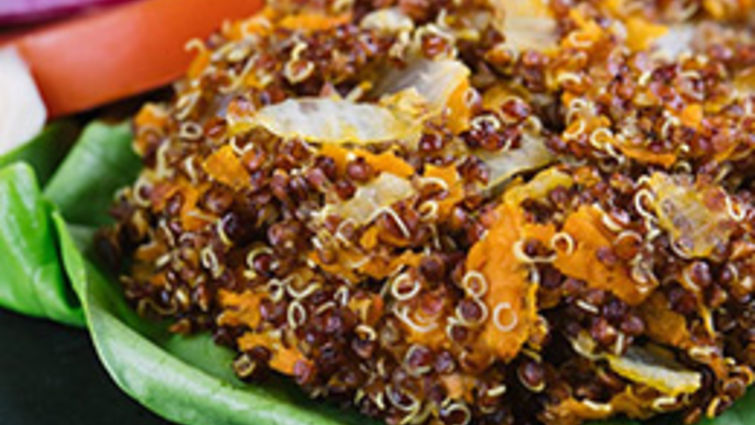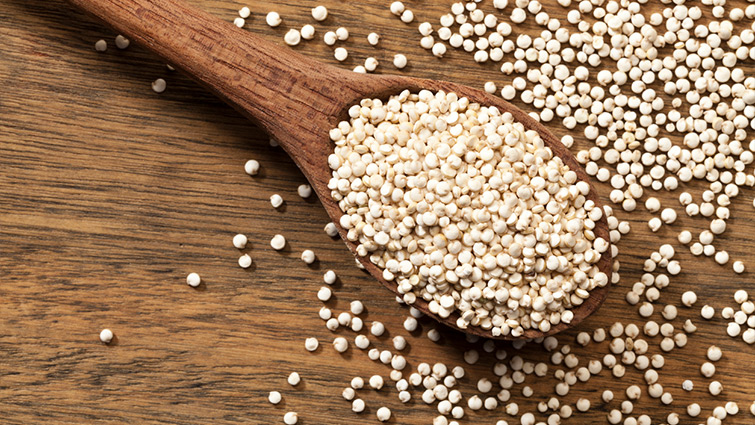Available in English, Spanish, French, Chinese, and Portuguese.
#liveitlomalinda
With quinoa as the meat substitute, sweet potato as the binder and a garlic/herb mixture as the flavorful accent, this gluten free burger is perfect for sinking your teeth into.

Recipe: Gluten-Free Quinoa Burgers
Serving size: 123g
Servings per recipe: 7
- 2 Cup red quinoa, cooked and unrinsed
- Butter or oil for sautéing
- 1 Sweet onion, diced
- 1 Sweet potato, grated
- 1 Tbsp. coconut oil
- 3 Cloves garlic, minced
- Herb of your choice
Directions
Preheat over to 350°. Heat 1.5 cups of water. Add 1 C raw quinoa. Bring to a simmer and allow to cook for 5 min, turn off heat, leave lid on and let sit for 15-20 minutes until all the water is absorbed.
Sauté the onion, garlic, and potato with a little oil or butter. Add all the ingredients into a bowl. Add in 1 whole egg and 1 egg white. Mix well and form into patties. Bake on a non-stick mat or oiled baking sheet for 25-30 minutes.
Freezer friendly.
To freeze: Place parchment paper between the patties so they don’t stick together.
Nutrition Facts
Serving size:
| Calories | 98 |
| Total Fat | 4g |
| Saturated Fat | 2g |
| Trans Fat | 0g |
| Cholesterol | 3mg |
| Sodium | 46mg |
| Total Carbohydrate | 15g |
| Dietary Fiber | 2g |
| Total Sugars | 3g |
| Includes 0g Added Sugars | |
| Protein | 2g |
| Vitamin D | 0mcg |
| Calcium | 24mg |
| Iron | 1mg |
| Potassium | 152mg |

Star Ingredient:
Quinoa Contain:
Manganese*
What is manganese? A trace mineral essential for the body to metabolize fats and carbohydrates. In the body, it is found mostly in the bones and glands and is a cofactor for many enzymes, helping to facilitate dozens of metabolic processes. Manganese requirements are low, and plant foods such as nuts, whole grains, and green leafy vegetables contain significant amounts of this trace mineral. Deficiencies are therefore unlikely.
Magnesium*
Magnesium is critical for the operation of hundreds of enzymes. It acts in all the cells of the soft tissues where it forms part of the protein-making machinery and is necessary for the release of energy. Magnesium helps relax muscles after contraction and promotes resistance to tooth decay by holding calcium in tooth enamel. Magnesium rich food sources include dark green leafy vegetables, nuts, legumes, whole grain breads and cereals, seafood, chocolate and cocoa. Magnesium is easily lost from foods during processing, so unprocessed foods are the best choices.
Folate*
Did you know folate is part of the B-vitamin family, otherwise known as vitamin B9? It is active in cell division. During periods of active growth and cell division, such as pregnancy and adolescence, folate needs to increase, and deficiency is especially likely. The best food sources of folate are liver, legumes, green leafy vegetables, and beets. Among the fruits, they are oranges, orange juice, and cantaloupe. Heat and oxidation during cooking and storage can destroy up to half the folate in foods.
*These statements have not been evaluated by the Food and Drug Administration. This is not intended to diagnose, treat, cure, or prevent any disease.







